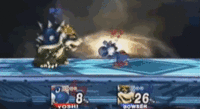Dragonic Reverse
The Dragonic Reverse (sometimes abbreviated as DR), is a pseudo-wavedash technique which can be used by Yoshi in Super Smash Bros. Brawl.
How it works
When Yoshi performs a double jump in Brawl, he will move downwards for a few frames before he starts rising. Yoshi cannot land while performing his double jump but if he performs an aerial during the double jump's startup, he can land. Dragonic Reverse essentially works by Yoshi immediately double jumping and performing an aerial so he can land just after the double jump begins.
The game actually has a fail safe in order to make sure that Yoshi cannot use his aerials to land during the double jump's falling frames. If Yoshi double jumps close enough to the ground, there will be seven frames where Yoshi will be unable to perform an aerial or an air dodge (there is usually a one frame delay where this cannot happen). While this fail-safe does exist, there are two ways to bypass the fail-safe and allow Yoshi to immediately land with a double jump aerial.
Execution
There are two ways to perform a Dragonic Reverse although one method is easier and more optimal than the other.
The first method is performed by using an instant double jump aerial. Yoshi has to buffer a double jump and an aerial during his jumpsquat (which is 6 frames long) and if he performs it correctly, he will double jump and perform an aerial on the first frame he is in the air. In Brawl, a player cannot normally double jump and perform an aerial on the same frame as the aerial input will out-prioritise the jump input but if the player buffers both options, they will both be done on the same frame. Yoshi has to buffer both inputs otherwise, Yoshi will go into the seven frame aerial lock-out window. If Yoshi performs it correctly, Yoshi will land on frame 2 of the aerial's animation which will cause the aerial to auto-cancel (regardless of which aerial Yoshi uses). This technique is very difficult to perform as it requires very tight execution. The player has to jump, jump again and perform an aerial, all with a six frame (1/10th of a second) window. Even if the player uses two different jump buttons, they have to let go of the first jump button in order for the second one to work.
The second method is slightly slower and it is even harder to perform but it still technically works. For the second method, Yoshi has to perform a short hop, perform a double jump on the second frame of his short hop and then he has to perform an aerial on the second frame of his double jump. If Yoshi double jumps too late, he cannot land when performing the aerial and if he double jumps at the right time but performs the aerial too late, he will go into the seven frame aerial lockout window. This method is even more difficult as the player has to perform two frame perfect inputs in a row which cannot be buffered. This method is also slower, taking two more frames to perform than the first method which makes this method almost completely useless overall.
When landing, if the control stick is tilted forwards, Yoshi will slide forwards a little and if it is held backwards, Yoshi will slide backwards a little.
Yoshi can also perform a Dragonic Reverse by simply using a double jump and performing an aerial just before landing although using the trick in this way is much less useful as landing normally will have largely the same effect.
Uses
The Dragonic Reverse is an extremely hard technique to master due to the timing and execution involved, but there are many applications to this technique. Most of its applications are the same as the wavedash in Melee. As Yoshi is essentially performing an instant soft landing (which is only 2 frames) while also sliding, it is possible to perform anything out of it, including all of Yoshi's ground moves, shield/grab or jump. It is also possible to quickly dodge attacks with it, then counterattack, which is much faster to perform than a roll or a dash back.
Yoshi's triple jump
The Dragonic Reverse can only be performed with aerials and not with an air dodge. This is because if Yoshi double jump and air dodges close enough to the ground, he will not land. If Yoshi does perform an air dodge instead of an aerial in situations where he would get a Dragonic Reverse, Yoshi will instead gain an additional double jump despite already using his double jump.
Triple jumping is overall much more situational and risky but it can be used in order to catch opponents recovering high or to simply give Yoshi more mobility options in the air. Yoshi can use his second double jump at any time and he can even use it close to the ground to give himself another triple jump, which he can do as many times as he likes. This overall makes the triple jump similar to a Second Jump Recovery, though the trick is easier and more useful than most SJRs.
